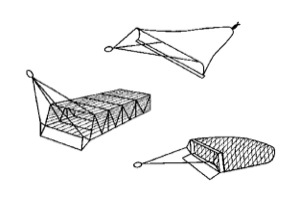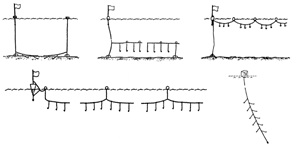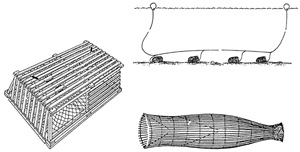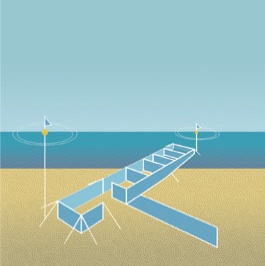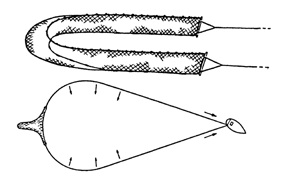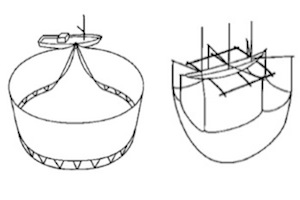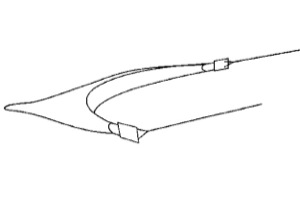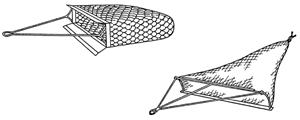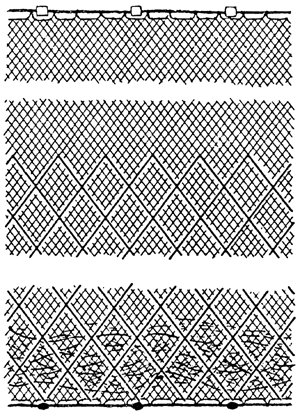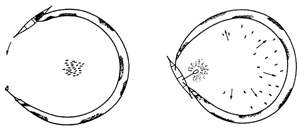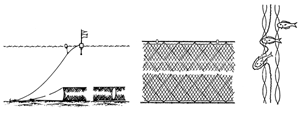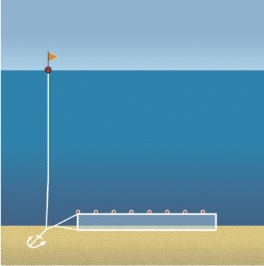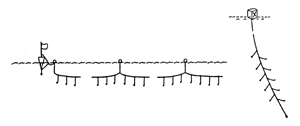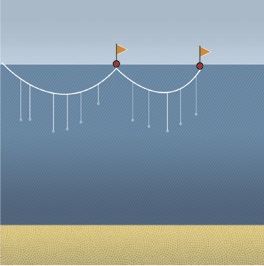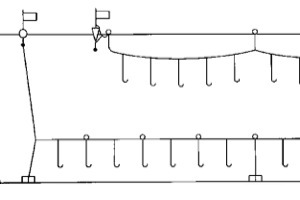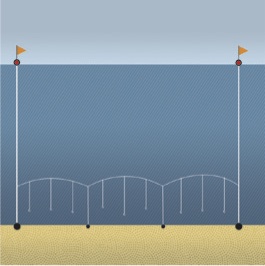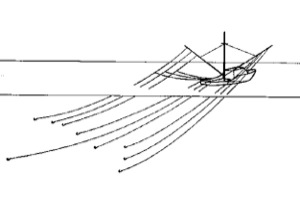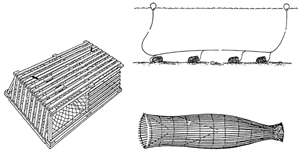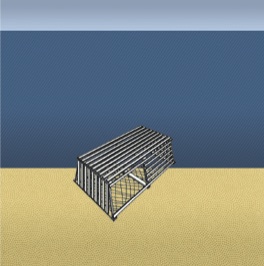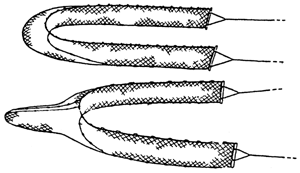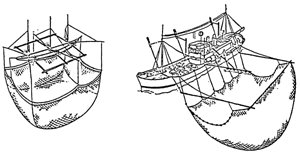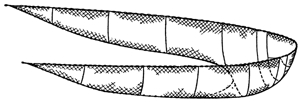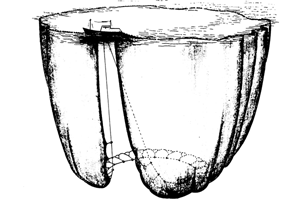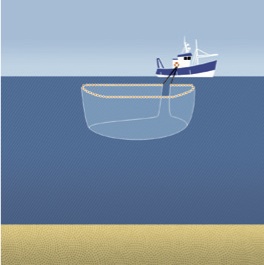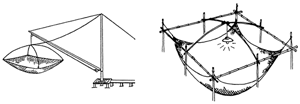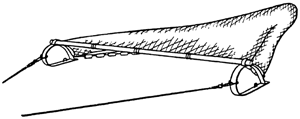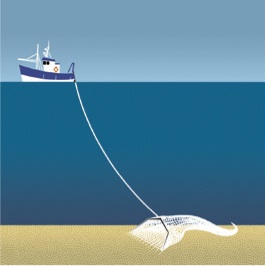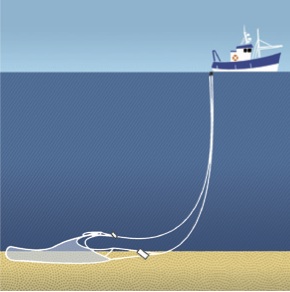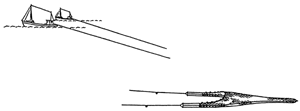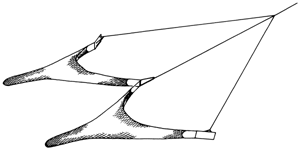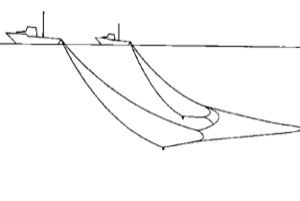Dredges
Dredges are gears which are dragged along the bottom to catch shellfish. They consist of a mouth frame to which a holding bag constructed of metal rings or meshes is attached.
-
-
A gear consisting of a mouth frame to which a holding bag constructed of metal rings or meshes is attached. Boat dredges are principally of two variants: dredges that scrape the surface of the bottom and dredges that penetrate the sea bottom to a depth of 30 cm or more.
Related links
-
-
A small, light dredge consisting of a mouth frame attached to a holding bag constructed of metal rings or meshes. It is operated by hand in shallow waters, from the shore or from a boat.
Related links
-
-
A gear that digs molluscs out of the bottom by means of powerful underwater jets. The catch may be transferred to the boat by a conveyor belt device or by a suction pump.
Related links
Related links
Gillnets and similar nets
Gillnets and entangling nets are strings of single, double or triple netting walls, vertical, near by the surface, in midwater or on the bottom, in which fish will gill, entangle or enmesh.
-
-
A bottom-set gear made with a gillnet, whose lower part is replaced by a trammel net.
Related links
-
-
A net kept on the surface, or at a certain distance below it, by numerous floats. It drifts freely with the current, separately or, more often, with the boat to which the net is attached.
Related links
-
-
A gillnet generally used in shallow water and set vertical to encircle fish. After the fish have been encircled by the net, noise or other means are used to force them to gill or entangle themselves in the netting surrounding them.
Related links
-
-
A gillnet consisting of a single netting fixed to the bottom, or at a certain distance above it, by means of anchors or weights.
Related links
-
-
A bottom-set net made with three walls of netting, the two outer walls being of a larger mesh size than the loosely hung inner netting panel. The fish get entangled in the inner small meshed wall after passing through the outer wall.
Related links
Related links
Hooks and lines
Hooks and lines are gears where the fish is attracted by a natural or artificial bait (lures) placed on a hook fixed to the end of a line or snood, on which they get caught.
-
-
Handlines may be used with or without a pole or rod. For fishing in deep waters the lines are usually operated using reels. The bait used may be natural or artificial. This gear type includes the jigging lines, operated by hand and used on small boats.
Related links
-
-
Handlines can be worked mechanically, using powered reels or drum. They are generally used on medium size vessels, but they may also be used on relatively small boats. Pole-lines can also be mechanized, with the pole movement being entirely automatic.
Related links
-
-
A drifting longline consists of a mainline kept near the surface or at a certain depth by means of regularly spaced floats and with relatively long snoods with baited hooks, evenly spaced on the mainline. Drifting longlines may be of considerable length. Some drifting longlines are set vertically, each line hanging from a float at the surface.
Related links
-
-
Longlines consist of a main line, sometimes of considerable length, to which snoods with baited or unbaited hooks are fixed at regular intervals. The main line is set either horizontally on or near the bottom or less commonly near the surface.
Related links
-
-
A simple line, provided with natural or artificial bait and trailed near the surface or at a certain depth by a vessel. Several lines are usually towed at the same time, by using outriggers.
Related links
Related links
Pots and traps
Traps, large stationary nets or barrages or pots, are gears in which the fish are retained or enter voluntarily and will be hampered from escaping.
-
-
A trap, designed to catch fish or crustaceans, in the form of cages or baskets made from various materials (wood, wicker, metal rods, wire netting, etc.) with one or more openings or entrances. It is usually set on the bottom, with or without bait, singly or in rows, connected by ropes (buoy-lines) to buoys on the surface showing its position.
Related links
Related links
Seines
A seine net is a very long net, with or without a bag in the centre, which is set either from the shore or from a boat for surrounding a certain area and is operated with two (long) ropes fixed to its ends (for hauling and herding the fish).
-
-
A seine operated from land, generally used in shallow waters, near the shore; the bottom and surface act as natural barriers which prevent the fish from escaping from the area enclosed by the net.
Related links
-
-
A seine operated from a boat in the open sea, composed of a bunt (bag or lose netting) and long wings often lengthened with long towing ropes or warps.
Related links
-
-
A seine net designed for pair fishing, where two boats operate the net in pair.
Related links
-
-
Seine net which is set from a free-floating marker buoy; when the vessel has reached the buoy again, it is lifted aboard, the two ends of the hauling lines are connected to the winch and dragging and hauling begins from the forward-moving vessel.
Related links
Related links
Surrounding nets and lift nets
Surrounding nets are large netting walls set for surrounding aggregated fish both from the sides and from underneath, thus preventing them from escaping by diving downwards. Lift nets are horizontal netting panels or bag shaped like a parallelepiped, pyramid or cone with the opening facing upwards which are submerged at a certain depth, left for a while, the time necessary for light or bait to attract fish over the opening, then lifted out of the water.
-
-
A lift net consisting of a horizontal netting panel or a bag shaped like a parallelepiped, pyramid or cone with the opening facing upwards. The catching process is supported by lights or simply some bait. Lift nets are hauled out by hand or mechanically from one or more boats.
Related links
-
-
A surrounding net with the central bunt in the form of a spoon and two lateral wings, making it possible to retain the shoal of fish when the two wings are hauled up at the same time. These nets are generally operated by a simple boat, relatively small.
Related links
-
-
A net characterised by the use of a purse line at the bottom of the net. The purse line enables the net to be closed like a purse and thus retain all the fish caught. Purse seines, which may be very large, are operated by one or two boats.
Related links
-
-
A lift net usually operated from stationary installations situated along the shore, where the lifting system are sometimes mechanized.
Related links
Related links
Trawls
The trawl nets are cone-shaped net (made from two, four or more panels) which are towed, by one or two boats, on the bottom or in midwater (pelagic).
-
-
A trawl consisting of a cone-shaped body ending in a bag or codend, which retains the catch. The horizontal opening of the net is provided by a beam, made of wood or metal, which may be 10 m long or more.
Related links
-
-
A cone-shaped net consisting of a body, normally made from two, four and sometimes more panels, closed by one or two codends and with lateral wings extending forward from the opening. It is operated by a single boat and it is kept open horizontally by two otter boards.
Related links
-
-
A trawl consisting of a cone-shaped body, normally made of two or four (and sometimes more) panels, closed by a codend and with lateral wings extending forward from the opening. It is operated and held open horizontally by two boats.
Related links
-
-
A cone-shaped net which is towed in mid-water. It consists of a cone-shaped body, normally made of four panels, ending in a codend and the net has lateral wings extending forward from the opening. It is operated by a single boat and the horizontal opening is maintained by otter boards.
Related links
-
-
A gear comprising two identicaltrawl nets working together, opened horizontally by a single pair of otter boards. The inner wings are attached to a sledge towed simultaneously with the otter boards from a common crowfoot.
Related links
-
-
A trawl designed and rigged to work in midwater. It is towed simultaneously by two boats, thus ensuring the horizontal opening of the net.
Related links
Related links
Data sources
